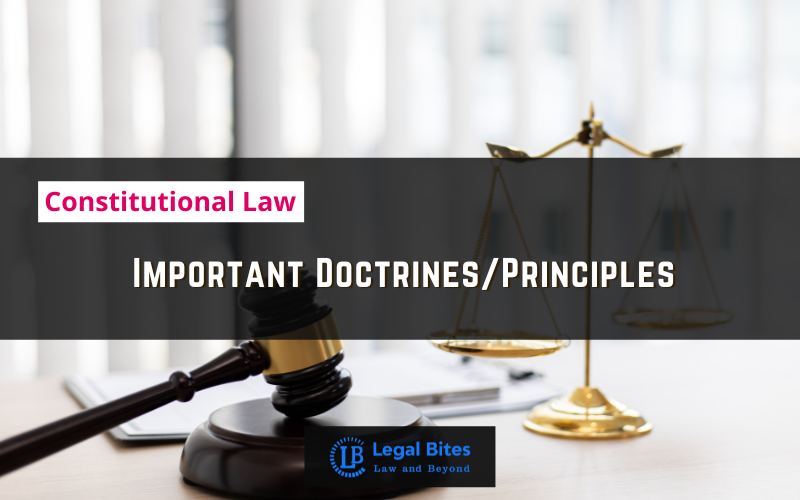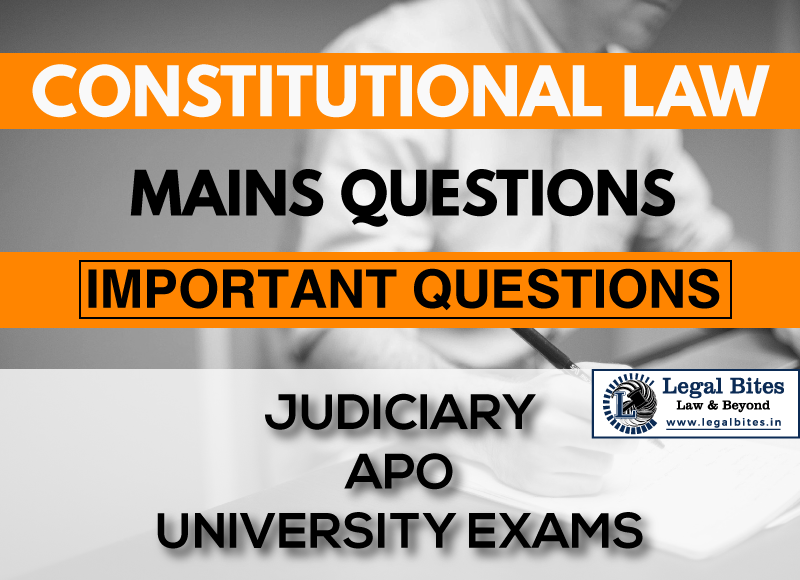Centre-State Financial Relationship: Taxing Powers Of The Union And State
This article on Centre-State Financial Relationship discusses Taxing Powers Of The Union And State. The way in which taxing powers are allocated between the Centre and the States in India has helped in avoiding the Centre-State conflicts which other federal countries have faced or are grappling with. I. Centre-State Financial Relationship: Taxing Powers Of The Union And State… Read More »
;
This article on Centre-State Financial Relationship discusses Taxing Powers Of The Union And State. The way in which taxing powers are allocated between the Centre and the States in India has helped in avoiding the Centre-State conflicts which other federal countries have faced or are grappling with. I. Centre-State Financial Relationship: Taxing Powers Of The Union And State Just as the legislative and executive powers have to be divided as between the Federal and State Governments, so...
This article on Centre-State Financial Relationship discusses Taxing Powers Of The Union And State. The way in which taxing powers are allocated between the Centre and the States in India has helped in avoiding the Centre-State conflicts which other federal countries have faced or are grappling with.
I. Centre-State Financial Relationship: Taxing Powers Of The Union And State
Just as the legislative and executive powers have to be divided as between the Federal and State Governments, so also the power to raise the necessary financial powers must be divided, under any federal Constitution.
The Central and State Governments in a federal nation should be autonomous in their respective spheres as outlined by the Constitution, independent of each other. Therefore, in distributing the financial powers it should be ensured that each of the two Governments must have the power to raise financial resources necessary to perform its executive functions.
Further, the power of the respective governments in this behalf should ideally be independent of each other, because if the State Governments have to depend substantially on the union financial reserves, it might indirectly result in the state governments losing their autonomy in other matters.
In practice, however, the above two principles of an ideal distribution have not been observed under any federal Constitution. The reason is that no Constitution, made at a point of time, can envisage with precision, the financial requirements of a growing social economy. In the result, under almost every federal Constitution, the inadequacy of states finances has to be met by discretionary grants made by the Union to the State Governments which brings in some degree of federal control over local affairs.
II. How this Distribution is sought to be achieved in India
There is complete separation of Union and State taxing powers in the financial provisions of the Indian federal system. The whole taxing area has been divided between the Union and the States in a way that the possibility of double taxation is avoided. The Constitution of India provides separate legislative heads of taxation to the Centre and the States.
The taxes enumerated in the Union List (List I, Entries 82 to 92, 92A, 92B, 96 & 97) are leviable by the Centre exclusively. The taxes enumerated in the States List (List II, Entries 45 to 63 and 66) are leviable by the state exclusively. There are a few tax entries in the Concurrent List (List III Entries 35, 44 and 47).
It is so to avoid problems of overlapping and multiple-taxation between the Centre and the States which have arisen in some other federal countries. Allocation of the heads of taxation between the Union and the States is based on the broad principle that taxes which are location-specified relate to the subject of local consumption and have therefore been assigned to the States.
The Union Government is responsible for issues that usually concern the country as a whole, for example, national defence, foreign policy, railways, national highways, shipping, airways, post and telegraphs, foreign trade and banking. The State Governments are responsible for other items including, law and order, agriculture, fisheries, water supply and irrigation, and public health.
Some items for which responsibility vests in both the Centre and the States include forests, economic and social planning, education, trade unions and industrial disputes, price control and electricity. Then, there is a devolution of some powers to local governments at the city, town and village levels.
The taxing powers of the Central Government encompass taxes on income (except agricultural income), excise on goods produced (other than alcohol), customs duties, and inter-state sale of goods. The State Governments are vested with the power to tax agricultural income, land and buildings, sale of goods (other than inter-state), and excise on alcohol. Local authorities such as Panchayat and Municipality also have power to levy some minor taxes.
Division of financial powers and functions among different levels of the federal polity are asymmetrical, with a pronounced bias for revenue taxing powers at the Union level while the States carry the responsibility for subjects that affect the day to day life of the people entailing larger expenditure than can be met from their own resources.
Finance Commission
On average, the revenue of States from their own resources suffices only for about fifty to sixty per cent of States’ current expenditure. Since the insufficiency of the States’ fiscal resources had been foreseen at the time of framing the Constitution, a mechanism in the shape of Finance Commission was provided under Article 280 for financial transfers from the Union.
The Finance Commission is only one stream of tr ansfer of resources from the Union to the States.
The Planning Commission, which has been abolished and been replaced with the NITI Aayog, advises the Union Government regarding the desirable transfer of resources to the States over and above those recommended by the Finance Commission.
III. Central Taxes
Central taxes are those taxes levied exclusively by Central Government under List I (Union List, Entries 82 to 92, 92A, 92B, 96 & 97) of the VIIth Schedule of the Constitution of India.
Union taxes are of several types
- First, there are some taxes such as stamp duties are imposed by the Union but are collected and taken by the States.[1]
- Second, taxes, for example, succession and estate duties (except on agricultural land), taxes on railway fares and freights, etc. are imposed and collected by the Union, but the entire proceeds are distributed among the States.[2]
- Third, there are some taxes such as taxes on non-agricultural income (and the Union excise duties which may be shared with the State) which are levied and collected by the Union, but the proceeds thereof are shared between Union and State.[3]
- Fourth, there are certain taxes such as corporation tax; custom duties are levied, collected and appropriated by the Union. Besides, the Union Parliament is authorised by the Constitution to increase any of the duties or taxes mentioned in Articles 269 and 270 by a surcharge for exclusive Union purposes.[4]
Taxes on income other than agricultural income
The power to levy income-tax is divided between the Centre and the States. The Centre can levy a tax on non-agricultural income, while tax on agricultural income is assigned to the states (entry 46, List II). The tax under Entry 82 of List I includes income from property even where such property is in the owner’s own occupation, as in the case of a housed or that which can be converted into income.[5]
Duties of customs including Export Duties
It is the tax imposed on import and export. The Centre can levy duties on imports into, and exports from, the country. Customs is a tax on consumption outside the taxing State or on home consumption of goods imported from abroad.
Duties of excise on tobacco and other goods manufactured or produced in India
The exceptions under this sub-heading are: (a) alcoholic liquors for human consumption; (b) opium, Indian hemp and other narcotic drugs and narcotics, but including medicinal and toilet preparations containing alcohol. The Union has the power to levy excise duty on tobacco and medicinal and toilet preparations containing alcohol, under Entry 84 of List I.
The definition of the word ‘manufacture’ in this entry has raised some controversy. ‘Manufacture’ is not equal to ‘processing’. According to Supreme Court in Union of India v. Ramlal Mansukhrai[6], ‘manufacture’ means “bringing into existence a new substance’ and does not mean merely “to produce some change in a substance”, however minor in consequence the change may be.
Corporation Tax
Companies pay corporation tax on their income, in case of which the following conditions are fulfilled[7]:
- It is not chargeable in respect of agricultural income;
- The companies paying the tax are not authorized to deduct the same from dividends payable by the companies to individuals;
- No provision exists for taking the tax so paid into the account in computing for the purposes of income-tax the total income of individuals receiving such dividends or in computing tax payable by or refundable to, such individuals.
Wealth tax
Under Entry 86 of List I the Centre can levy wealth tax. The basis of taxation is the total capital value of assets (including lands and buildings), minus the debts and liabilities. It is not imposed on the components of the assets of the assessee but on the totality of all the assets owned by the assessee; its principle is aggregation.[8]
The Wealth Tax Act enacted by Parliament was challenged on the ground that the expression ‘net wealth’ in that Act included non-agricultural lands and buildings and so the tax fell within the domain of the state legislatures under Entry 49, List II. The Supreme Court rejected the contention and ruled that wealth-tax is not levied directly on land and building. It is levied on the total assets of a person of which land building may be component and so wealth tax does not fall under Entry 49, List II which envisages the levy of tax on lands and buildings or both as units.
Tax on lands and buildings is directly imposed on lands and buildings and bears a definite relation to them. Entry 49 is more general in nature, while entry 86 is more specific in nature. Therefore, in case of conflict between entry 86, List I, and entry 49, List II, entry 86, i.e. the former prevails.[9]
Estate Duty and Succession Duty
There is one feature common to both taxes, which is that the occasion for the levy is the death of a person, but while Succession Duty (Entry 88 of List I) has reference to the acquisition of the property by the successor and generally takes into account the extent of the benefit derived by him and other considerations relevant from that point of view, the Estate Duty has reference to the value of the property constituting the estate of the deceased and is independent of the question as to who takes it.[10]
While a succession duty falls upon the person who takes the property of the deceased, an estate duty falls upon the property whoever may be the successor to the property on the death of the previous owner.
Terminal taxes
These taxes are levied on goods or passengers carried by railway, sea or air; and taxes on railway fares and freights. While the present Entry gives to the Union the power to levy terminal taxes on goods or passengers carried by railway, sea or air, Entry 52 of List II gives power to the State to levy taxes on the entry of goods into a local area for consumption, use or sale therein. E
ntry 56 of List II, on the other hand, empowers the State to impose taxes on goods and passengers carried by road, on inland waterways, or national highways.[11]
Taxes on transactions in stock exchanges
Entry 48, List I, relates to stock exchanges and futures markets. Thus, the whole area of stock exchanges falls to the centre.
- Taxes on the sale or purchase of newspapers and on advertisements published therein.
- Taxes on the sale of newspapers and on newspaper advertisements has been made a central subject.
- Taxes on services (This Entry has been inserted by the Constitution (Eighty-eighth Amendment) Act, 2003.)[12]
Residuary Power of Taxation
Union Government has exclusive powers to impose taxes which are not specifically mentioned in the state or concurrent lists. Some taxes imposed using these powers include Gift tax, Wealth tax and Expenditure tax.[13]
IV. State Taxes
State taxes are those taxes levied exclusively by the State Government under List II (State List, Entries 45 to .63 and 66) of the VIIth Schedule of the Constitution of India. Within the jurisdiction of States are more taxes concerned with land, such as land revenue, agriculture income and land succession taxes, estate duties in respect of agricultural land, and also the excise duties on alcoholic liquors and narcotics. Also, among state tax heads are sales taxes, taxes on professions and callings and taxes on vehicles, on passengers travelling by roads or inland waterways, and on luxuries and amusements.[14]
The State Governments are vested with the power to tax agricultural income, land and buildings, sale of goods (other than inter-state), and excise on alcohol. Local authorities such as Panchayat and Municipality also have power to levy some minor taxes.
The following are some sources of revenue for State Governments[15]
- Taxes and duties related to agricultural lands
- Capitation Taxes
- Excise on liquors, opium etc.
- Fees on matters related to state list except court fee
- Land Revenue, Land and buildings related taxes
- Rates of Stamp duties in respect of documents other than those specified in the Union List.
- Taxes on mineral rights subject to limitations imposed by the parliament related to mineral development.
- Taxes on the consumption or sale of electricity.
- Sales tax on goods (other than newspapers) for consumption and use within state.
- Taxes on advertisements except newspaper ads.
- Taxes on goods and passengers carried by road or on inland waterways
- Taxes on vehicles, animals and boats, professions, trades, callings, employments, luxuries, including the taxes on entertainments, amusements, betting and gambling.
- Toll Taxes.
The way in which taxing powers are allocated between the Centre and the States in India has helped in avoiding the Centre-State conflicts which other federal countries have faced or are grappling with. Indeed, it was a noble step taken by Constitution framers.
[1] Article 268(1) of the Indian Constitution
[2] Article 269(1) of the Indian Constitution
[3] Article 270(1) and Article 272 of the Indian Constitution
[4] Article 271 of the Indian Constitution
[5] Bhagwan v. Union of India, AIR 1981 SC 907
[6] 1971 1 SCR 936
[7] Article 366(6) of the Indian Constitution.
[8] Union of India v. H.S. Dhillon, AIR 1972 SC 1061
[9] Sudhir Chandra Nawn v. WTO, AIR 1969 SC 59
[10] Re: Duty on Non-Agricultural Property, AIR 1944 FC 73.
[11] International Tourist Corporation v. State of Haryana, AIR 1981 SC 774
[12] Schedule VII, List I, Entry 92-C, Constitution of India
[13] Union of India v. H.S. Dhillon AIR 1971 SC 1061, and Azam Jah v. ITO Hyderabad, AIR 1972 SC 2319.
[14] Constitution of India, Schedule VII, List II, Entries 45 to 63.
[15] Id.




